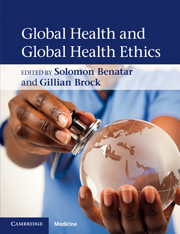Book contents
- Frontmatter
- Contents
- List of contributors
- Introduction
- Section 1 Global health, definitions and descriptions
- 1 What is global health?
- 2 The state of global health in a radically unequal world: patterns and prospects
- 3 Addressing the societal determinants of health: the key global health ethics imperative of our times
- 4 Gender and global health: inequality and differences
- 5 Health systems and health
- Section 2 Global health ethics, responsibilities and justice: some central issues
- Section 3 Analyzing some reasons for poor health
- Section 4 Shaping the future
- Index
- References
5 - Health systems and health
Published online by Cambridge University Press: 01 March 2011
- Frontmatter
- Contents
- List of contributors
- Introduction
- Section 1 Global health, definitions and descriptions
- 1 What is global health?
- 2 The state of global health in a radically unequal world: patterns and prospects
- 3 Addressing the societal determinants of health: the key global health ethics imperative of our times
- 4 Gender and global health: inequality and differences
- 5 Health systems and health
- Section 2 Global health ethics, responsibilities and justice: some central issues
- Section 3 Analyzing some reasons for poor health
- Section 4 Shaping the future
- Index
- References
Summary
What are health systems for?
It is easy to forget that one of the primary purposes of a health system should be to improve health (McKee, 1999). For decades, debates on health systems have been dominated by discussions of how much they cost to run (typically questioning whether they are affordable, as if there was an alternative in a civilized society) or how many resources they require (typically expressed in an arbitrary fashion as people, usually doctors and nurses but not managers or physiotherapists, or facilities and items of furniture, usually hospitals but not primary-care clinics or beds, but not examination couches). The nature of this discourse has meant that health systems have tended to be regarded as a cost to society from which there is little return, instead of as an investment whereby appropriately directed expenditure leads to better health. Indeed, some studies even suggested that more resources were associated with higher mortality, possibly as a consequence of higher rates of discretionary surgery (Cochrane et al., 1978), a finding supported by the observation that death rates fell when doctors went on strike (Roemer, 1981).
This chapter is based on a very different vision, in which health, health systems and economic growth can exist together, in a mutually supportive virtuous circle. Drawing on work undertaken for a ministerial conference organized by the European Region of the World Health Organization in Tallinn, Estonia, in 2008, it builds on what is now a substantial body of research on these three sets of mutual inter-relationships (Figure 5.1).
- Type
- Chapter
- Information
- Global Health and Global Health Ethics , pp. 63 - 74Publisher: Cambridge University PressPrint publication year: 2011



